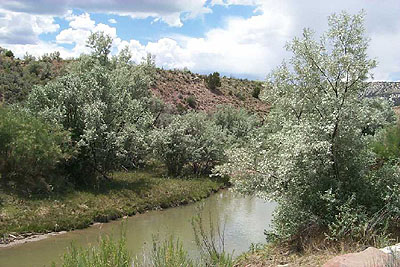
Elaeagnus angustifolia (light green) growing along a river in Sevier Co., Utah. (J.S. Peterson @ USDA-NRCS PLANTS Database)
Plant Link - Elaeagnaceae
All species in the Elaeagnaceae examined are nodulated only by Frankia strains belonging to phylogenetic Cluster 3 . Sequencing of 16S rRNA genes and DNA-DNA hybridization have indicated that isolated strains are diverse within the confines of Cluster 3 (Fernandez, et al., 1989; Huguet, et al., 2001; Nazaret, et al., 1989), although Cluster 3 16S rRNA gene sequences from the field reveals that some strains or strain groups are cosmopolitan (Clawson, et al., 1998; Nalin et al., 1997). Identical partial 16S rDNA gene sequences have been derived from E. angustifolia and Myrica pensylvanica nodules from Connecticut, an E. pungens in Hamilton, New Zealand, and Discaria trinervis, Talguenea quinquenervia, Trevoa trinervis and an unidentified Elaeagnus in Chile (Clawson, et al., 1998). The same sequence belongs to a major group of strains in France (Ea1-2, HR27-14) (Jamann, et al., 1992). This finding probably reflects the conserved nature of the DNA region that was sequenced but it does suggest that a related group of elaeagnus strains is widely distributed in nature. One study that looked at the distribution of elaeagnus strains in a soil column yielded seven PCR-RFLP profiles of DNA from nodules induced by trapping experiments. Six corresponded to previously identified genomic species and the seventh was unique. Thus, a relatively high diversity was found in the samples but it was within the bounds of the diversity of strains known to infect the plants (Nalin, et al., 1997).
In Europe, Elaeagnus spp. have been recently introduced but Hippophae rhamnoides was present throughout Europe during all stages of the late glaciation and probably helped maintain the populations of Cluster 3 frankiae (Jamann, et al., 1992). The same situation holds for North America where most Elaeagnus species are introduced and universally nodulated. The native Shepherdia is infected by a wide variety of Cluster 3 frankiae that most likely also infect introduced Elaeagnus spp. (Huguet, et al., 2001).